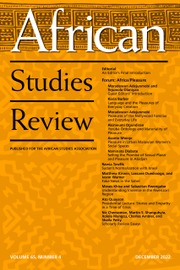Kofi Anani’s Leadership in Independent Africa argues that postcolonial states have misconstrued democratic governance in Africa by eroding grassroot participation, transparency, representation, and accountability through the exclusion of traditional leadership systems. Departing from the modernist assumptions that chieftaincy would not survive the postcolonial period, Anani foregrounds the resilience and contemporary relevance of African traditional political structures. According to Anani, by privileging liberal democratic regimes and sidelining African traditional political systems, postcolonial African states have perpetuated political systems that are not suited to local realities. Anani further contends that marginalizing traditional leadership in favor of the wholesale adoption of Western democracy foster corruption, unaccountability and little or no participation of the masses in governance. To address these deficiencies, Anani proposes the Blended Representative Principle (BRP), a hybrid governance model that combines Western democratic/multiparty democracy at the national level with indigenous governance at the local level. Anani’s BRP model is therefore neither a mere dismissal of Western democracy, nor a simple incorporation of a traditional leadership system into modern governance practices, but rather an invitation to sharpen democratic practice on the continent by enhancing representation, political participation and accountability (8).
The book is divided into ten chapters. Chapters One and Two provide an overview of the BRP concept and its analytical underpinnings. Anani builds the BRP model on Ghana’s local government system (municipal and district assemblies) and does not consider the different local government arrangements in other parts of Africa (3). Chapters Three to Five provide the justification for the BRP model. In these chapters, Anani traces the colonial legacies that shaped the denigration of everything African leading to the demonization and attacks on the traditional African leadership systems as outmoded. Here, Anani could have provided more context by giving historical examples, including the abolition of chieftaincy by some postcolonial African leaders such as Ahmed Sekou Toure of Guinea in 1957 and Milton Obote of Uganda in 1966. Anani, however, quickly turns his attention to critically assess the shortcomings of Western democratic institutions in Africa, noting their lack of grassroot participation and weak accountability mechanisms (52). In contrast, Anani demonstrates how traditional authorities have historically galvanized community engagement, embodying representative accountability, even in recent crises such as the Covid-19 pandemic.
In the operational chapters (Chapters Six to Ten), Anani outlines concrete mechanisms for implementation of the BRP. In these chapters, Anani calls for a rethinking of governance in Africa based on his observation that many African states constitutionally recognize chiefs yet formally exclude them from political office. Anani coins Trans-Serve (transformation and servant) leadership as a new language for debates on Africa’s political renewal and suggests the creation of new educational institutions, particularly the National Taskforce on Operationalization (NATFO), as central to the operationalization of BRP. Furthermore, Anani discusses how the BRP can leverage institutions such as the African Traditional Leadership Union (ATLU) and the African Continental Free Trade Area (AfCFTA) to diffuse the BRP model across the continent.
Leadership in Independent Africa is a bold attempt at reimagining the future of governance and leadership in Africa. For Anani, democracy and chieftaincy could exist with one another. Traditional authority holders in many parts of Africa have built resilient political structures that are even dominant and more participatory than the state. Yet, even when they are involved in governance, chiefs are assigned a “backseat role in local government designs” across Africa (82), deepening our understanding of how formal laws shape and constrain chiefly authority. For example, while Ghana’s constitution recognizes the role of chiefs, they are barred from participating in politics. In South Africa, the constitution recognizes the status of traditional leaders according to customary law, but they occupy the bottom of the hierarchy of the local government structure (81).
While the BRP highlights the resilience and participatory strengths of traditional institutions, most of Anani’s analysis is centered on the weakness of Western democracy and the strengths of traditional systems of government. A critical analysis of the institution of chieftaincy and traditional governance itself is necessary to ensure effective governance in a BRP model. As an institution that draws its legitimacy from tradition, chieftaincy is not a timeless institution. It has changed over time, and its practice varies in different parts of the continent. What aspects of the institution, and its customary practices require reform to ensure transparency and good governance? How would a BRP model work under different traditional systems, particularly in highly centralized systems and non-centralized contexts? Anani’s analysis underestimates chieftaincy disputes (92). How do we deal with the endemic chieftaincy disputes across Africa under a blended system?
While these questions underscore the need for further inquiry into the evolving institution of chieftaincy and the BRP itself, it further suggests that the implementation of the BRP model may vary across different local contexts. Nonetheless, Anani’s BRP model provides an insightful rethinking of African democracy by offering a compelling hybrid that promises deeper citizen engagement and accountability. This book serves as an invaluable resource not only for scholars and students in politics, history, sociology, and international relations, but also for policymakers. Its greatest contribution lies in sparking debates over how Africa’s political future can reconcile pluralistic ideals with indigenous legitimacy.

